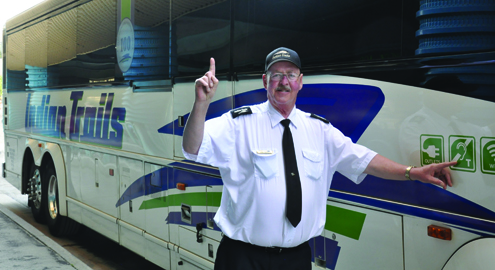

Accommodations for an aging America are good business
By David Hubbard
With the aging process, as many Americans over 50 can attest, typically come issues associated with hearing. Aging is an unavoidable fact of life for the otherwise indomitable baby boomers, but the majority of them are not nearly as accepting of their fate as previous generations. Striving to continue to live healthy and active lifestyles, this older generation is insisting on accommodations that help them never feel excluded.
According to Todd Billin, president of Hearing Loop Systems, Holland, MI, hearing loss is the issue over any other that causes aging Americans to withdraw from society. For that reason, Billin encourages passenger carriers that cater to charter tour and travel not to overlook or dismiss this critical special needs area.
“As people begin experiencing difficulty communicating with others or understanding spoken messages in public places, their tendency will most likely be to withdraw and quit traveling,” he says. “Demographics alone suggest any sudden lack of business from this group would be a devastating blow to the travel and tourism industry — especially for companies not keeping up with the technology to cater to this group.”
Billin further suggests that in a competitive business environment, a company with the savvy to accommodate this group will actually gain an edge over their competition. He says they’ll receive a great deal of gratitude for thinking to provide hearing loop technology.
What is a hearing loop?
A person using a hearing aid with a hearing loop can switch to T-mode to receive from telecoil rather than normal microphone mode.
This simple, venerable technology is essentially a wire attached to the sound source that extends around a space such as a bus interior or transportation terminal. The wiring enables hearing aids equipped with tiny telecoils of copper wire, or T-coils, to receive and amplify a single source of sound transmitted electromagnetically to a hearing aid from a telephone, television or PA system.
Last year, Indian Trails, Inc., Owosso, MI, received grants from the Michigan Department of Transportation (MDOT) fleet to provide hearing loops on 17 motorcoaches that operate on scheduled routes throughout the Michigan peninsulas, as well as systems in the Bay City and Saginaw terminals.
Hearing Loop Systems worked with Indian Trails on the installation. The company brings over 30 years of experience into installing audio/video systems for all types of commercial establishments. It’s the leading provider of loop systems. Hearing Loop Systems is developing systems for all types of facilities across the U.S. such as the Breslin Center Arena at Michigan State University and all the passenger terminals at Grand Rapids’ Gerald R. Ford International Airport.
“Hearing loops are an enormous improvement to the onboard experience of many of our passengers who are hard of hearing,” says Indian Trails President Gordon Mackay. “The cost of about $800 per bus is relatively low and we hope to eventually install hearing loops on all our motorcoaches and in all our bus stations.”
Chad Cushman, Indian Trails vice president, business and administration, says that while he hasn’t received a lot of feedback, he has heard from customers who appreciate the accommodation. They’re pleased they can take advantage of the technology while they are riding the coaches, he says.
“As people are in transit and rarely report in, I suppose no news is good news,” he says. “We promoted our hearing loops heavily at the install. We posted the icons to alert those with hearing aids of the availability of hearing loops. People are just using them as we intended.”
Cushman says a coming customer survey on all the coach systems provided for route service will invite further comment from those taking advantage of the hearing loops.
“MDOT was very excited about this opportunity to provide funding to Indian Trails,” says Cushman. “The department is pleased to be able offer yet another amenity that ADA passengers can use for a more comfortable transit experience.”
Advocates speak
David G. Myers, a professor of psychology at Hope College, Holland, MI, has hearing loss and is one of the nation’s foremost advocates for hearing loops. He runs the website www.hearingloop.org.
“The Indian Trails/MDOT installation on inter-city buses is a model of transportation accessibility for the entire country,” says Myers. “Hearing loops are not being installed in the U.S. because our federal disability laws require most public facilities with 50 or more seats to provide unspecified assistive listening devices, such as earphones and pocket–size receivers — which most people with hearing loss won’t bother with.”
The Hearing Loss Association of America (HLAA), Bethesda, MD, is the country’s leading advocacy organization for people with hearing loss, providing resources for individuals and families to learn how to adjust to living with hearing loss.
HLAA Executive Director Brenda Battat says the organization fully supports hearing loop technology for the independence it invites.
“Emphasis over the last three years has been on assisted technology such as FM frequency and infrared, which require hand-held receivers and other apparatuses,” she says. “Hearing loops are not as obtrusive and offer seamless access to facilities and services that would normally cause a hearing-impaired person a lot of frustration. Pushing a button on a hearing aid is a lot easier.”
“We give Indian Trails high praise for responding to the needs of our members, and essentially stepping up as the leader in their industry,” adds Battat. “Hopefully others will follow.” BR
